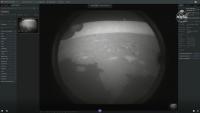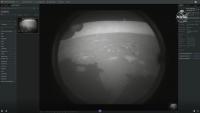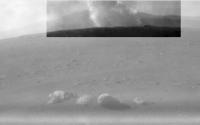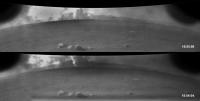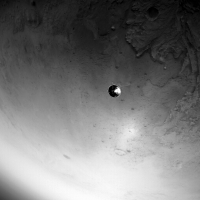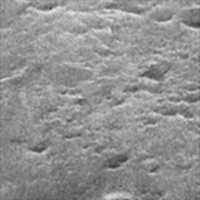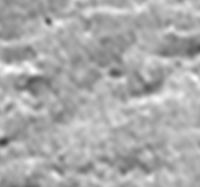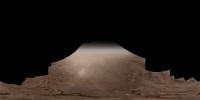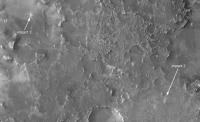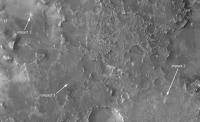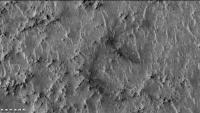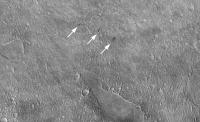Printable Version of Topic
Click here to view this topic in its original format
Unmanned Spaceflight.com _ Perseverance- Mars 2020 Rover _ Perseverance EDL
Posted by: nprev Feb 2 2021, 10:02 AM
Good morning from Los Angeles! Today of course is the big day, and this where we'll talk about Perseverance's entry, descent, and landing. For those members who haven't been on UMSF during a Mars landing, days like this have been quite a bit of fun--enjoy! ![]()
Please see the http://www.unmannedspaceflight.com/index.php?showtopic=8589 thread for links to various ways to watch it happen. NASA TV coverage is now live at 0930 PST (1730 UTC). UMSF's own Emily Lakdawalla, author of "The Design and Engineering of Curiosity", will be hosting a https://youtu.be/woab2wX5Db4 of her own and her highly informed commentary interspersed with real-time events from JPL will be a first-class option.
Here's the planned sequence of events in Earth-received time (US Pacific Standard Time) and UTC. Times are of course approximate; there may be variations on the order of a few seconds. Get your peanuts and beverage of choice ready, and let's land on Mars!!!
12:38 (2038 UTC)- Cruise stage separation
12:48 (2048 UTC)- Atmospheric entry interface
12:49 (2049 UTC)- Peak heating, peak deceleration
12:52 (2052 UTC)- Chute deploy
12:52:20 (2052:20 UTC)- Heat shield separation
12:54 (2054 UTC)- Backshell separation, beginning of powered flight
12:55 (2055 UTC)- Skycrane, touchdown
Posted by: climber Feb 18 2021, 06:21 PM
Peanuts ready here, go Perseverance ![]()
![]()
![]()
Posted by: MahFL Feb 18 2021, 07:01 PM
![]()
![]()
![]()
![]()
![]()
![]() indeed !
indeed !
Posted by: Marvin Feb 18 2021, 07:12 PM

Posted by: nprev Feb 18 2021, 07:18 PM
Livecast from JPL live now on NASA TV.
Posted by: Marvin Feb 18 2021, 07:27 PM
As Emily mentioned in her blog, the NASA Media stream has no commentators, just JPL call outs:
https://www.nasa.gov/multimedia/nasatv/#media
So far, everything is A-OK
Posted by: jamescanvin Feb 18 2021, 07:57 PM
Emily's show is now live.
https://www.youtube.com/watch?v=woab2wX5Db4
Posted by: ugordan Feb 18 2021, 07:57 PM
https://www.nasa.gov/multimedia/nasatv/#media
Also available here: https://www.youtube.com/watch?v=kPrbJ63qUc4
Posted by: nprev Feb 18 2021, 08:14 PM
Eyes On The DSN showing four antennas on Percy right now.
Posted by: climber Feb 18 2021, 08:18 PM
Lets' go for ONE peanut ![]()
![]()
Posted by: MahFL Feb 18 2021, 08:23 PM
They keep saying "meters" to target. Is the target the landing spot they would like below the cliffs ?
Posted by: Mercure Feb 18 2021, 08:35 PM
Pistachios finished, switching to peanuts, on my mark, GO!
Posted by: nprev Feb 18 2021, 08:38 PM
Cruise stage sep!!!!
Posted by: climber Feb 18 2021, 08:41 PM
See the carrier in Green Bank
Posted by: Marvin Feb 18 2021, 08:43 PM
MRO will relay live data, 5 minutes to entry interface
Posted by: Pando Feb 18 2021, 08:44 PM
I'm back.
whohooo!
Posted by: atomoid Feb 18 2021, 08:44 PM
Here we go.. white knuckles ![]()
![]()
![]()
![]() Local brewery's timely release standing by, for however it goes...
Local brewery's timely release standing by, for however it goes...
Posted by: climber Feb 18 2021, 08:46 PM
whohooo!
Welcome back !!!!!
Posted by: nprev Feb 18 2021, 08:47 PM
Deploy peanuts at entry interface!
Posted by: nprev Feb 18 2021, 08:48 PM
Entry interface.
Posted by: Pando Feb 18 2021, 08:48 PM
My Eyes on Mars crashed. Mars turned into a black hole. lol
Posted by: TheChemist Feb 18 2021, 08:49 PM
Fingers crossed, the forum ghosts are back ![]()
Posted by: nprev Feb 18 2021, 08:52 PM
CHUTE!!!!
Posted by: phase4 Feb 18 2021, 08:54 PM
My kids ate all my peanuts. Just when things get exciting ![]()
Posted by: Antdoghalo Feb 18 2021, 08:54 PM
Same here
Posted by: nprev Feb 18 2021, 08:54 PM
POWERED FLIGHT!!!
Posted by: nprev Feb 18 2021, 08:56 PM
TOUCHDOWN!!!!!
Posted by: Mercure Feb 18 2021, 08:56 PM
Tango Delta nominal Touchdown!
Posted by: TheChemist Feb 18 2021, 08:58 PM
Congratulations to everybody, Persy has landed. ![]()
Posted by: Marvin Feb 18 2021, 08:58 PM
Outstanding! Images incoming.
Congratulations to NASA and JPL.
Posted by: nprev Feb 18 2021, 08:58 PM
FIRST HAZCAM PICS!
Posted by: Phil Stooke Feb 18 2021, 08:59 PM
No longer turning blue. Excellent! Yes, there will be a map thread.
Phil
Posted by: fredk Feb 18 2021, 09:00 PM
Hazcam thumbnail - have you identified any features, Phil? ![]()
Posted by: phase4 Feb 18 2021, 09:00 PM
Yes! Pictures! Congratulations Rover team!!!!!!!
Posted by: nprev Feb 18 2021, 09:01 PM
Let's start migrating the discussion to the newhttp://www.unmannedspaceflight.com/index.php?showtopic=8591&st=0 thread! ![]()
Posted by: angel1801 Feb 18 2021, 09:02 PM
I watched the landing live on a Youtube stream.
Posted by: akuo Feb 18 2021, 09:03 PM
Well done team! Go Percy!
Posted by: paxdan Feb 18 2021, 09:04 PM
Huzzah!
Posted by: Olympusmonsuk Feb 18 2021, 09:08 PM
That ladies and gentlemen is how you land on Mars. Well done,
Posted by: Nix Feb 18 2021, 09:11 PM
Phew ![]() . Congratulations!
. Congratulations!
Posted by: Steve G Feb 18 2021, 09:12 PM
Congratulations. Amazing job. My heartbeat is still in triple digits. Never in doubt, right?
Posted by: Tom Tamlyn Feb 18 2021, 09:20 PM
Emily Lakdawalla's broadcast was great.
Posted by: ElkGroveDan Feb 18 2021, 09:20 PM
No images yet .... ![]()
https://mars.nasa.gov/mars2020/multimedia/raw-images/
Posted by: Steve5304 Feb 18 2021, 09:20 PM
Not lately. Seems like NASA has figured mars out.
We are 5-5 since the Polar Landers I think..i think i may be missing one here? Martians must be thinking its an invasion.
Spirit
Oppo
Phoenix
Curiosity
Perseverance
Ill be very interested in the Tianwen-1 rover lander to see how that goes
Posted by: ElkGroveDan Feb 18 2021, 09:21 PM
Agree. Haven't seen Emily in several years. She doesn't seem to age.
Posted by: Julius Feb 18 2021, 09:24 PM
Congrats to the Mars 2020 team on a successful landing of Percy Rover on Mars.
Posted by: Steve G Feb 18 2021, 09:26 PM
Lander used 305 out of 401 Kgs of fuel, and flew away with 96 kgs. Lots of reserves left over.
Posted by: MERovingian Feb 18 2021, 09:26 PM
Warmest congratulations to all of JPL!! What a great achievement, once again!
I'm so glad these seven minutes are behind us!
Phew!
Posted by: MERovingian Feb 18 2021, 09:29 PM
We are 5-5 since the Polar Landers I think..i think i may be missing one here? Martians must be thinking its an invasion.
Spirit
Oppo
Phoenix
Curiosity
Perseverance
Ill be very interested in the Tianwen-1 rover lander to see how that goes
Steve, you forgot InSight
Posted by: climber Feb 18 2021, 09:30 PM
We are 5-5 since the Polar Landers I think..i think i may be missing one here? Martians must be thinking its an invasion.
Spirit
Oppy
Phoenix
Curiosity
Perseverance
Ill be very interested in the Tianwen-1 rover lander to see how that goes
And InSight...
Posted by: scorpion136 Feb 19 2021, 01:29 AM
During the press conference it was noted that velocity at entry interface was ~12,000 mph. IIRC Curiosity's entry interface speed was about 13,000 mph. Did they extend the coast phase a bit to have a lower entry interface speed because this is a heavier payload than Curiosity, or was this just rounding error in the presser?
Posted by: climber Feb 19 2021, 01:10 PM
US Mars landings technics so far :
Powered descent : 4
Air Bags : 3
SkyCrane : 2
Lithobraking : 1
Posted by: pioneer Feb 19 2021, 01:50 PM
Powered descent : 4
Air Bags : 3
SkyCrane : 2
Lithobraking : 1
Powered descent: Viking 1 & 2, Phoenix and INSIGHT
Air bags: Pathfinder, Spirit and Opportunity
Skycrane: Curiosity and Perseverance
Which one did the lithobraking?
Posted by: Paolo Feb 19 2021, 02:07 PM
Mars Polar Lander
Posted by: Alan Stern Feb 19 2021, 02:32 PM
And the New Millennium penetrators as well.
Posted by: John Whitehead Feb 19 2021, 04:04 PM
Does anyone know when we get to see the video from the sky crane camera looking at Perseverance and vice versa, also the camera looking at the ground during EDL? Please post links when appropriate.
Posted by: Explorer1 Feb 19 2021, 04:56 PM
Near term, the press conference in about an hour is my best bet for EDL: https://www.youtube.com/watch?v=Xz-Id5ZNopM
Posted by: mcaplinger Feb 19 2021, 05:12 PM
BTW, the documentary "Built for Mars: The Perseverance Rover" on NatGeo last night was excellent. Usually I find these things pretty cringeworthy for a variety of reasons, but this one was great. As someone who has on occasion gotten to be a technician (I torqued several screws on MCZ) it's a nice perspective of what it's like to build flight hardware, not often seen on TV.
Posted by: John Whitehead Feb 21 2021, 05:24 AM
This is regarding remaining fuel in the sky crane, as discussed in post numbers 126, 131, 142, 146, 150, 151, 155, 157, 158, and 167 in the topic "Perseverance Lands In Jezero Crater, Sol 0-." I will put a note in that other topic to point here (the EDL topic).
The second link in Post 167 explains that the sky crane engines are run at full throttle until the fuel depletes (page 12, upper left corner).
https://trs.jpl.nasa.gov/bitstream/handle/2014/41708/08-0255.pdf
That was for MSL, and a similar publication from the 2019 IEEE Aerospace Conference says the same for Mars 2020.
(Nelessen et al, Mars 2020 Entry, Descent, and Landing System Overview)
The third and fourth links in Post 167 show that the fuel is hydrazine, pressurized by helium gas.
https://trs.jpl.nasa.gov/bitstream/handle/2014/44159/13-0606_A1b.pdf
https://trs.jpl.nasa.gov/bitstream/handle/2014/44137/13-0737_A1b.pdf
In the fuel tanks, the helium is separated from the liquid by flexible bladders, so there is no mixing, and the liquid can be used up without the helium getting to the engines. Upon ground impact, the pressurized helium is still in the tanks and certainly there is some residual liquid (in tanks and in tubing), so one would expect that the tanks burst open and the remaining liquid decomposes quickly. The main reason for the bladders is to keep the helium away from the tank outlet tubes to the engines, so that the engines receive only liquid during intense maneuvering (liquid slosh).
A few of the posts used the word "hypergolic," which usually refers to fuel and oxidizer burning on contact. While hydrazine is hypergolic with some oxidizers, there is no oxidizer in the sky crane. The engines have catalyst to cause a decomposition reaction (N2H4 goes to H2, N2, and NH3 gases at high temperature).
From 1988 to 1994, I was a customer at the company that had built the Viking engines in the seventies (then Rocket Research, now part of Aerojet). I got to know engineers who subsequently dusted off the Viking design and made modifications for MSL, used again for Mars 2020 (way to go folks!). I agree that propulsion engineers would like for the rover to visit the sky crane crash site.
Posted by: MahFL Feb 21 2021, 05:29 AM
Adam said in his slightly drunken (whiskey
Posted by: MahFL Feb 21 2021, 05:41 AM
Glad you mentioned the show, watching it now, 3 mins in and it's awesome.
Posted by: djellison Feb 21 2021, 08:46 PM
Sorry to belabor this point - but they are not. I asked the EDL Phase lead. I refer you again to this paper : https://ieeexplore.ieee.org/stamp/stamp.jsp?tp=&arnumber=8742167
Posted by: dmuller Feb 21 2021, 10:17 PM
Some googling gives me speed at EI of 19,000 km/h for Percy and 21,250 km/h for MSL.
MSL and Percy had quite different trajectories getting to Mars. I think what makes the main difference in the relative speed between Mars and the spacecraft is that Percy carried "excess" speed that would have taken it 10m km further away from the Sun than Mars was at landing (if Mars hadnt "run over" Percy on the way); that additional speed means the difference to Mars' speed was a tad less than for MSL. MSL's aphelion was pretty much exactly the distance to Mars at landing, so it was at its slowest in its orbit. MSL was closer to the Sun at landing, but also had a lower perihelion.
I dont know if that was part of the design to be able to land a heavier payload. I also most vaguely seem to remember that the 7 minutes of terror for MSL was more like 6 minutes. Memory a bit vague, it was nearly 10 years ago. How time flies ...
Percy
Distance to Sun at landing: 235m km
Aphelion: 243m km
Perihelion: 151m km
Eccentricity: 0.2322
MSL
Distance to Sun at landing: 230m km
Aphelion: 230m km
Perihelion: 147m km
Eccentricity: 0.2188
Source: SSD Horizons. Orbital elements before Mars' gravity started to affect them.
Posted by: PDP8E Feb 22 2021, 02:34 AM
I guess this belongs in the EDL thread... Perseverance hasn't quite landed.
This is a highly tinkered image to bring out the engine swirls (equalized, curves, etc)
I haven't lined up any rocks with the Hazcam shots yet... (is the vehicle drifting?) ... and there is an interesting 'rock' at the far-left middle
Posted by: MrNatural Feb 22 2021, 02:44 PM
I don't know about the rest of you, but I am really, really impressed by the performance of the Terrain Relative Navigation (TRN) during EDL. If you look at the landing site, you can see all sorts of hazards such as dune fields and boulders that TRN successfully avoided. Congrats to the team; I cannot imagine how challenging the engineering was for this.
I had a different sort of EDL question: does the thickness of Mars' atmosphere vary enough to necessitate course and trajectory corrections just before EDL?
Posted by: MahFL Feb 22 2021, 06:32 PM
I had a different sort of EDL question: does the thickness of Mars' atmosphere vary enough to necessitate course and trajectory corrections just before EDL?
They had a target box they were in 2 days before entry, the thickness does affect how far up range or downrange of the target you go, they do guidance when on the heat shield to hit the target landing spot, ofc we do not know how much deflection TRN did to get to a safe spot, might have been 20 meters, who knows ?, but that ofc is after the time on parachute.
Posted by: John Whitehead Feb 22 2021, 06:37 PM
Besides the "whether or not," it is more interesting to know the pros and cons, why (or why not) the sky crane should use up the hydrazine before crashing.
For example, it seems to make sense to fly the skycrane as far away as possible, so maybe the EDL Phase Lead could shed further light on why not to do that.
Posted by: Pando Feb 22 2021, 08:56 PM
Full video - a few seconds before touchdown.
Amazing.
https://youtu.be/4czjS9h4Fpg
Posted by: Phil Stooke Feb 22 2021, 09:10 PM
Skycrane crash: Don't forget that a plan published in the past (over a year ago in the case of that paper) might not match the current thinking, so the mission might not follow exactly what was discussed earlier. Also, it seems they had plenty of fuel to spare, so if it did use all the fuel it might end up way out in the delta somewhere, where the rover might want to be later on.
Posted by: Mercure Feb 22 2021, 09:27 PM
Ouch, do we have to mistrust the published technical literature?
Besides the "whether or not," it is more interesting to know the pros and cons, why (or why not) the sky crane should use up the hydrazine before crashing.
For example, it seems to make sense to fly the skycrane as far away as possible, so maybe the EDL Phase Lead could shed further light on why not to do that.
It turned out to be good to "mistrust" the published technical literature since Alan Chen confirms that it indeed no longer reflects the procedure used.
Science, generally, is based on "mistrusting" as long as you do it in an evidence-based manner...
Posted by: nprev Feb 23 2021, 12:31 AM
Spent all day working at the job that pays me, just saw the video. RIDICULOUSLY cool, utterly mind-blowing!
Posted by: MarT Feb 23 2021, 02:13 AM
Just a quick and dirty run on the Perseverance Rover Down-Look camera. Just quick corrections applied.
https://youtu.be/vkhzyxqQeus
Credit for the data and the whole accomplishment of landing another rover on Mars:
NASA/JPL-Caltech
Sources:
https://mars.nasa.gov/mars2020/multimedia/raw-images/
https://www.youtube.com/watch?v=4czjS9h4Fpg
I have trouble downloading all the data in bulk. Can anyone point me to a trick? Is there another place to download the data with wget possibly?
Posted by: James Sorenson Feb 23 2021, 02:24 AM
I am having that same issue. I usually just use a JSON list, like the one that Curiosity has and the DownThemAll firefox plugin. But I'm having trouble locating a simular JSON file for Perseverance. I am aware of the raw image site API quick "hack" to pull up a partial JSON list, but it seems to be very limited. Any other ways to bulk download, I'm also all ears.
Posted by: MahFL Feb 23 2021, 05:38 AM
Does anyone know if the springs on the heat shield are supposed to be captured or not ?
Posted by: Greenish Feb 23 2021, 05:38 AM
Assume you've already tried this, and I'm learning as I go here. The default one limits to 50-images per page. But by messing with that query you can get a huge file with all images and their data (at least for a given sol), including direct filename links, pointing data, subframe, etc...You're looking for something else?
For Perseverence, "https://mars.nasa.gov/rss/api/?feed=raw_images&category=mars2020&feedtype=json&sol=0&order=sol+desc&&&extended=" gets at present a 6.5MB file with details for the 3559 sol 0 images there right now.
For example on sol 2 one "full res" link is "https://mars.nasa.gov/mars2020-raw-images/pub/ods/surface/sol/00002/ids/edr/browse/rcam/RRB_0002_0667129492_604ECM_N0010052AUT_04096_00_2I3J01.png")
There are other fields too. If you know an image filename you can go straight to the metadata for that image, e.g. "https://mars.nasa.gov/rss/api/?feed=raw_images&category=mars2020&feedtype=json&id=RRB_0002_0667129492_604ECM_N0010052AUT_04096_00_2I3J01"
If I knew anything about web development I'd try to reformat and post it for general use somehow.
Posted by: stevesliva Feb 23 2021, 05:52 AM
Press conference said that the free spring was surprising, but not alarming. It sure is neat to watch, though.
Posted by: MarsInMyLifetime Feb 23 2021, 08:59 AM
If I knew anything about web development I'd try to reformat and post it for general use somehow.
That query is perfect for redisplaying from their site. I'm sure there are better ways, but your question piqued my interest. I got this far using PHP to decode a result from the API for display, say in a sidebar widget in WordPress (and maybe add a link to the large version, etc.).
$url = 'https://mars.nasa.gov/rss/api/?feed=raw_images&category=mars2020&feedtype=json&id='.$mfn;
$data = file_get_contents($url); // put the endpoint result into a variable
$array = json_decode($data, TRUE); // turn JSON feed into array
var_dump($array); // see the array structure for the specific image path
$image_caption = $array['image'][0]['caption']; // slice out the caption
$image_small = $array['image'][0]['image_files']['small']; // slice out the small image path
echo $image_caption.'<br/><img src="'.$image_small.'">';
Posted by: erentar Feb 23 2021, 12:25 PM
I have a python script that write all links to a file, then you can use wget on that
per_page = 100
total_images = json.loads(requests.get("https://mars.nasa.gov/rss/api/?feed=raw_images&category=mars2020&feedtype=json&num=0&page=0&order=sol+desc&&&extended=").text)["total_images"]
linksfile = open("jpl_raw_links.txt","a")
for i in range(math.ceil(total_images/per_page)):
data = json.loads(requests.get("https://mars.nasa.gov/rss/api/?feed=raw_images&category=mars2020&feedtype=json&num="+str(per_page)+"&page="+str(i)+"&order=sol+desc&&&extended=").text)
for i in range(int(data["per_page"])):
linksfile.write(data["images"][i]["image_files"]["full_res"]+"\n")
linksfile.close()
print("done")
Posted by: Mercure Feb 23 2021, 02:18 PM
Regarding the parachute movies/images. They're from two different upward-pointing cameras so in principle it should be possible for our imaging wizards to do a 3D-version. Can't think of a better subject matter for a 3D movie.
Posted by: Greenish Feb 23 2021, 02:32 PM
MarsInMyLifetime & erentar, so cool - I knew there were folks here with interest.
Note they do have a suggested way to embed images (in the sidebar of the individual image pages):
<iframe src="https://mars.nasa.gov/layout/embed/image/500raw/?i=NLM_0004_0667310972_991ECM_N0010052AUT_04096_00_2LLJ01" width="500" height="500" scrolling="no" frameborder="0"></iframe>
https://www.nasa.gov/multimedia/guidelines/index.html
In order to keep this thread focused on EDL rather than data wrangling, may I suggest we reconvene on http://www.unmannedspaceflight.com/index.php?showtopic=8514&hl= in the Image Processing Techniques subforum... looks like phase4's Marslife 3D browser is already playing with Percy images and y'all speak the same language I suspect
(unless the MODS think we can/should start a dedicated Perseverence image processing thread, as happened for MSL, Juno, etc.)?
Posted by: MarT Feb 23 2021, 04:03 PM
I have already had a look at it. But the second cam has only a few images. Anyway, it will be possible, but it will make your eyes hurt. The tangles from the parachute are right in between the both cams, if I interpreted the image correctly.
Also thanks everyone for the help with the code!
Posted by: ugordan Feb 23 2021, 07:04 PM
I really wish those of us outside the U.S. could also get to see these kinds of documentaries without this geo-lock stuff.
Posted by: xflare Feb 24 2021, 11:37 AM
The MARDI camera on Curiosity captured the heatshield impacting the surface while still on the parachute.
https://www.youtube.com/watch?v=vVLPXfF3l_U
It looks like the impact site for Perseverance's heatshield moved out of view while on the parachute???
EDIT: Have rewatched the decent video and im pretty sure the impact site goes out of view now.
Posted by: charborob Feb 24 2021, 02:09 PM
I was wondering at what moment exactly the upward-looking cameras on the backshell started recording images. Was it just before parachute deployment? Were they turned on during atmospheric entry and the peak heating phase? That might have been interesting.
Posted by: djellison Feb 24 2021, 03:38 PM
Turned on just before chute deploy - but behind the cover that comes off at deployment, hence some black frames at the start of the sequence
Posted by: Hungry4info Feb 24 2021, 11:42 PM
https://mars.nasa.gov/mars2020-raw-images/pub/ods/surface/sol/00000/ids/edr/browse/rcam/RRG_0000_0666952984_226ECM_N0010044AUT_04096_00_2I3J01.png raw image shows what I think we can much more confidently assert is the Skycrane crash plume. Marshall Eubanks on the Asteroid Explorer's Facebook https://www.facebook.com/groups/AsteroidExplorers/permalink/2863530843916938/ a contrast-enhanced image showing the plume in more detail, which I've attached here.
Edit: there's two images showing the plume, posted https://twitter.com/KAP_Jasa/status/1364706946478178312/photo/2. Also attached.
Posted by: Explorer1 Feb 25 2021, 12:14 AM
Certainly seems so much larger than the Curiosity plume (though that is a much lower quality image). Great catch!
Posted by: atomoid Feb 25 2021, 03:37 AM
I think there ever was only one frame of Curiosity's skycrane plume.
I'm not sure how many frames will come down for this one though, but hopefully a lot more, as it will be interesting to get a visceral sense of how the plume develops and decays within Mars' gravity and atmosphere.
Also quite surprising to me was the lack of any visible exhaust gas plume or heat refraction wavelet distortion emanating from the nozzles in the skycrane images as you would expect terrestrially, i guess it owes to the negligible atmospheric pressure being not enough to generate a refraction difference against the surrounding gasses perhaps. Video like this can really illustrate the otherworldliness of Mars so much better than anything else.
Posted by: ugordan Feb 25 2021, 09:06 AM
Yes, the Martian atmosphere is a pretty high vacuum from a rocketry perspective and so any gas exiting the nozzle will also tend to expand outward due to virtually no atmospheric backpressure - not like a tightly collimated exhaust plume you can get at 1bar on the surface of Earth.
Additionally, the hydrazine monopropellant thrusters use catalytic decomposition and the temperature goes up to around 1000 deg C in the chamber (quite a bit lower than a bipropellant fuel), but once it passes the chamber throat and starts expanding in the nozzle that exhaust will drop in temperature fast. The exhaust hitting the surface is moving fast, but it might not actually be all that hot*. Even if there was some refraction happening (IMHO I'm skeptical that it would be noticeable), it would happen some ways downstream where the chaotic mixing is strongest and neither camera view really showed that. Maybe if there was a camera on the rover looking sideways toward the horizon through the plumes, while hanging under the bridles something could have been seen, but at that point there was a lot of dust kicked up anyway.
* Well, "(not) hot" is probably the wrong term to use here, the gas molecules will have pretty much the same kinetic energy, it's just more directional than random. There probably is still quite a bit of localized shock heating once the plume hits the surface.
Posted by: Andreas Plesch Feb 25 2021, 08:59 PM
Comparing pre- and post-landing high resolution imagery shows that small (< 5m long) ripples or dunes just NW of the landing site appear to have been blasted away by the descent stage/sky crane.
pre-landing (25cm HiRISE mosaic)
post-landing (Mars2020 MRO image)
These ripples may represent the source of the majority of the dust seen in the descent video. One could probably estimate the volume (and the mass) of the apparently removed material. Perhaps the next generation hazard avoidance system could take such second order features into account since these small features could be identified in advance.
Here is a slide flip for checking map cross-registration:
http://bit.ly/PercyRIPPLEs
Sources:
https://planetarymaps.usgs.gov/mosaic/mars2...n0_first_dd.tif (> 9GB !)
https://mars.nasa.gov/system/downloadable_i...No-Contrast.jpg
Posted by: John Whitehead Feb 25 2021, 10:58 PM
Posted by: fredk Feb 26 2021, 01:33 AM
I was surprized when they showed the EDL videos so quickly considering those were supposed to be tens of thousands of frames. But I assume now that the frames were compressed into video onboard (they mentioned using ffmpeg) and sent back quickly. Now the raw frames will presumably take some time to return, but once we get them we will be able to make beautifully clean videos...
Posted by: MahFL Feb 26 2021, 05:29 AM
For future missions the EDL video was high priority, just incase anything bad happened to Percy before the info was transmitted.
Posted by: Andreas Plesch Feb 28 2021, 01:19 AM
I realized that you can actually see the ripple just to NW of the landing site mentioned above getting disrupted and eventually completely removed on the descent video. Here is a series of frames where I circled the ripple in red, and the landing site in blue, linked to the video at these times:
I learned that on youtube you can move back and forward by single frames with the ',' and '.' keys.
https://youtu.be/4czjS9h4Fpg?t=158
https://youtu.be/4czjS9h4Fpg?t=161
https://youtu.be/4czjS9h4Fpg?t=163
https://youtu.be/4czjS9h4Fpg?t=164
https://youtu.be/4czjS9h4Fpg?t=165
https://youtu.be/4czjS9h4Fpg?t=167
https://youtu.be/4czjS9h4Fpg?t=169
The white arrow points out what I think may be a sharper, retreating edge from blast erosion. Most of the erosion appears to occur during hovering in preparation for the "https://en.wikipedia.org/wiki/Abseiling" of the rover.
Posted by: fredk Mar 1 2021, 04:30 PM
I don't think that ripple is removed. In the hirise imagery the lighting is different before and after and it's the shadows that determine the visibility of the ripples. And in the landing images the dust kicked up blocks the direct sun and so reduces the visibility of the shadows.
If fact taking one of your frames with the ripple in question circled in red we can identify the same ripple in the rear hazcam imagery, as well as other ripples and rocks. Here I've identified features with the same colour outlining:
Posted by: MarkL Mar 1 2021, 08:27 PM
Has anyone found out why the secondary timestamp on the EDL image files are off from camera to camera?
For example, the A and B cameras looking upward at the parachute have different timestamps for images taken at the same time (eg parachute deploy).
https://mars.nasa.gov/mars2020/multimedia/raw-images/EAF_0002_0667110215_373ECV_N0010052EDLC00002_0010LUJ01
https://mars.nasa.gov/mars2020/multimedia/raw-images/EBF_0001_0667022753_744ECV_N0010052EDLC00001_0010LUJ01
These are both stamped Sol 2 when they are clearly sol 0. Is there a way to reconcile all these to a standard sequence so we know definitively what order they were take in?
The ground-pointing camera images from the descent also have differing timestamps.
M.
Posted by: mcaplinger Mar 1 2021, 08:35 PM
There are timestamp issues on the raw images website which are being worked on.
Posted by: MarkL Mar 2 2021, 05:48 PM
Thanks!
The video that came down of the landing seems to have been a separate file or series of files as pieces were missing in the raw images downloaded. Was a video stream generated by the EDL cameras and then uploaded straight to the DSN or were they programmed just to shoot stills at regular intervals which were then combined into a video?
Posted by: fredk Mar 2 2021, 06:07 PM
We heard they used ffmpeg on board, so they shot and stored the individual frames and then compressed them into video files before presumably sending the video files quickly to Earth after landing. Now we're waiting for the individual frames to come down, which will take a while since they sum to a much larger data volume than the compressed video.
Posted by: MarkL Mar 3 2021, 05:59 PM
Do you think we might get the actual videos? I would bet there are higher quality videos on the rover as they would have further compressed the camera output for rapid uplink after landing. Would there be raw video somewhere waiting to be uplinked? Or is it just a bunch of stills that have been fed into FFMpeg and we just have to wait for them to come down?
Posted by: fredk Mar 3 2021, 06:12 PM
I'm not sure what you mean by "raw" video. I don't see the point of processing less-compressed video (than the initial downlinked video) on board and sending that down. We'll be able to make superb quality video from the raw frames once they're all down.
Posted by: mcaplinger Mar 3 2021, 06:22 PM
This is educated speculation from reading the EDLcam paper and from what was said at the press conferences. What was sent down initially was the ffmpeg output produced onboard in the EDLcam Linux computer from the raw frames, and they are in the process of downlinking those raw frames now. What's on the raw images website from EDLcam in cases where the raw frame hasn't come down are the frames that were extracted from the ffmpeg file, and then processed however that website processes images in general. So there aren't any "higher quality videos" on the rover.
Basically what fredk said.
Posted by: JRehling Mar 3 2021, 07:01 PM
There are video compression algorithms that typically achieve much better performance than you would get from a sequence of n compressed images, and these take advantage of the fact that typically there is high correlation from one frame to another. For example, with video of a newscaster in a studio, the pixels representing the background, the desk, etc., don't often change from one frame to the next, so a compression algorithm can achieve big wins by storing only those portions of each frame which changed significantly from the last frame. However, with something like Perseverance's rapid descent, the fluttering of its parachute, etc., you have a lot more rapid change than you would normally expect.
Occasionally, you see compressed video break down suddenly and momentarily in quality when the frame-to-frame change exceeds expectations. One example I'll always remember is the way the image of the crowd "pixelated" when I was watching a basketball game on TV when there was a fast break in the game and the camera suddenly panned, causing the entire image to fluctuate from one frame to the next.
All that said, I'm not sure if either of these things was ever at a premium with the descent videos: (1) Returning to Earth, eventually, a video with the absolute highest degree of detail. (2) Achieving optimal bandwidth in the transmission of an initial compressed video.
It seems that with these videos "pretty good" is all that was needed in both respects. Descent video isn't the high-value science data for which the mission was launched.
Posted by: MarkL Mar 3 2021, 08:35 PM
Occasionally, you see compressed video break down suddenly and momentarily in quality when the frame-to-frame change exceeds expectations. One example I'll always remember is the way the image of the crowd "pixelated" when I was watching a basketball game on TV when there was a fast break in the game and the camera suddenly panned, causing the entire image to fluctuate from one frame to the next.
All that said, I'm not sure if either of these things was ever at a premium with the descent videos: (1) Returning to Earth, eventually, a video with the absolute highest degree of detail. (2) Achieving optimal bandwidth in the transmission of an initial compressed video.
It seems that with these videos "pretty good" is all that was needed in both respects. Descent video isn't the high-value science data for which the mission was launched.
Thanks for replying and agreed.
But it is very cool and will be an artifact of historic significance being the first video ever captured of a spacecraft during descent as well as the image data having been captured by very good cameras. It is also capable of providing a good quantity of valuable engineering data from chute deploy to TD and the more frames and higher quality the better.
My initial point was, where is the actual video file they uplinked? It was pretty high resolution. Maybe they can release it in raw form (unedited I mean).
Posted by: mcaplinger Mar 3 2021, 08:59 PM
They have said they were going to do that, and there are several thousand RDC raw frames on the website already, so why don't you give them a chance? It is only sol 13.
Posted by: MarkL Mar 3 2021, 09:06 PM
Point taken. ![]()
Posted by: djellison Mar 10 2021, 12:30 AM
All of them came down - including a view of the Heatshield impact.
Here's a page of just the LCAM pics, from Ryan's awesome raw browsing interface
https://rkinnett.github.io/roverpics/?mars2020&sol0&filter=ELM
(Congrats Mike C - great work from the La Jolla team)
Posted by: JRehling Mar 10 2021, 01:19 AM
That heat shield impact sequence is on the very short list of the greatest "action" videos in the history of planetary exploration!
Posted by: Andreas Plesch Mar 10 2021, 05:00 AM
Here is a quick animation of all the LVS frames: https://bit.ly/PercyLCAM
It will take a while before the higher resolution versions become available (looks like they did).
Posted by: xflare Mar 10 2021, 07:37 AM
WOW, iso it did catch the impact!!!!! I thought it had gone out of frame.
Posted by: Marvin Mar 10 2021, 01:09 PM
The heat shield took a quite the bounce when it impacted (cropped and zoomed):
Posted by: djellison Mar 10 2021, 02:09 PM
If it bounced it would be visible separately from the impact Ďsplatí in the crime scene HiRISE image.....which it isnít..
I think youíre seeing the dust cloud of impact and its shadow move with the wind. These are 1hz images, so itís actually pretty slow.
Posted by: MarT Mar 20 2021, 09:42 AM
Hi!
I tried to combine 23 of the LCAM images into a panorama. I combined that with the compressed RDCAM images, which I already had stitched. I filled the rest, which did not overlay, with cloned color. The colors for the atmosphere was taken from one of the PUCAM1 images. There is definetly no scientific value in this, as there was a lot of postprocessing involved. Stretching, contrast, brightness, sharpening, colorization, resolution upscaling etc. I tried to do it to my best understanding of what it would approximately look like from 11km above the Jezero crater. I will post a 360 version on youtube later. If someone is interested in the version without inpainted color, just say so ![]()
On Windows, I use FSPviewer to look at 360 images.
Youtube version:
https://www.youtube.com/watch?v=m1hwTNgZK7E
Posted by: Brian Swift May 14 2021, 11:19 PM
My take on processing the Descent Down-Look Camera raw images.
Left image colors are based on camera response and and illumination optimized from calibration target on top of rover, and includes chromatic adaption from modeled illuminant to D65 standard. In right image, only camera response is modeled and illumination is fixed at D65, so no chromatic adaption is applied.
Image processing done with custom software in Mathematica.
Mathematica notebook is open source and available at https://github.com/BrianSwift/image-processing
Notebook also contains links to various Mars 2020 and color processing papers and resources.
https://youtu.be/8Iz3yWrlWok
Posted by: MichaelJWP May 20 2021, 10:30 AM
Just wondered if anyone knows if there's been a report shared yet which compares how the EDL went in relation to what was expected?
Or is it too soon for that maybe?
Particularly interested in the improved guidance/hazard avoidance in Perseverance vs Curiosity and how that panned out.
Posted by: stevesliva May 20 2021, 05:46 PM
FWIW, you can read somewhat open discussion starting at 21:16 here:
https://www.rev.com/blog/transcripts/nasa-press-conference-transcript-february-22-perseverance-rover-searches-for-life-on-mars
... but I am not sure if not mentioning hazard avoidance is evidence of omission or omission of evidence, as they say.
Posted by: Phil Stooke Oct 29 2021, 08:35 PM
Waking up an old thread to mention the impacts of the two cruise balance masses. They were ejected just prior to arrival to allow control over the flight and struck the surface about 100 km west of the landing site. For Curiosity the same applied and the impact sites were imaged by HiRISE. Now with little fanfare we have the same for Perseverance, it seems. See the InSight thread for a reference to this in connection with an attempt by InSight to pick up a seismic signal.
This map locates the impacts:
The background is MOLA elevation and THEMIS daytime IR imaging. The overlay is a CTX image. The grid spacing is 0.1 degree or 6 km.
Phil
Posted by: Phil Stooke Oct 29 2021, 08:44 PM
This is part of HiRISE image ESP_069231_1990 showing two impacts with characteristics I would expect of spacecraft hardware (comparing especially with the Curiosity hardware impacts). They are about 3000 m apart in that image. The two balance masses for Curiosity were only 400 m apart, but two fragments of the cruise stage also struck nearby, a few km apart. For Perseverance, one of these might be the cruise stage, and a second balance mass impact has not yet been identified, or these could both be balance mass impacts and the cruise stage site has not been identified. Curiosity impac site ejecta was dark, here it is bright, probably just due to local conditions.
Phil
PS - another 6 small masses were ejected during flight. For Curiosity their impacts were a little downrange of the landing site. HiRISE has looked for their impacts but not seen them yet as far as I can tell from a cursory look.
Posted by: Phil Stooke Oct 29 2021, 09:37 PM
I just noted a third impact in this area:
The impact 3 - impact 2 vector is the direction of travel.
Phil
Posted by: Phil Stooke Mar 10 2022, 09:57 PM
I have now located the impact sites of the small balance masses west of the landing site. Quick look here, something more detailed later. The top image shows dark ejecta from two impacts. The bottom image shows three sites where new objects struck the surface - it's a before-after difference image of two CTX images. The Seitah-like structure south of the impacts can be found quite easily within Jezero if you are so inclined. As I say, a better representation of this will follow. Yesterday my LPSC poster said these had not been found yet. Today I finally noticed them.
The top image is the easternmost of the three arrows in the lower image. HiRISE image ID is in the file name if you download the image.
Phil
Powered by Invision Power Board (http://www.invisionboard.com)
© Invision Power Services (http://www.invisionpower.com)


